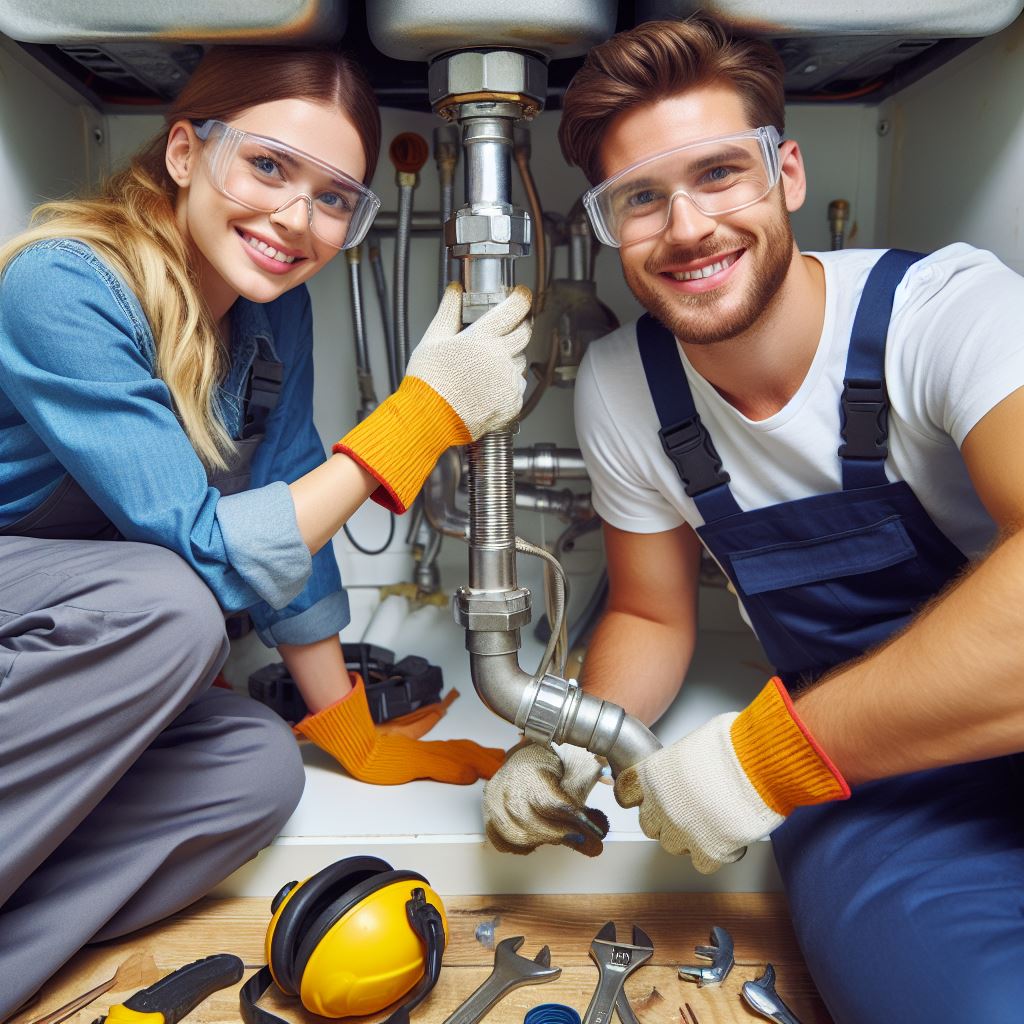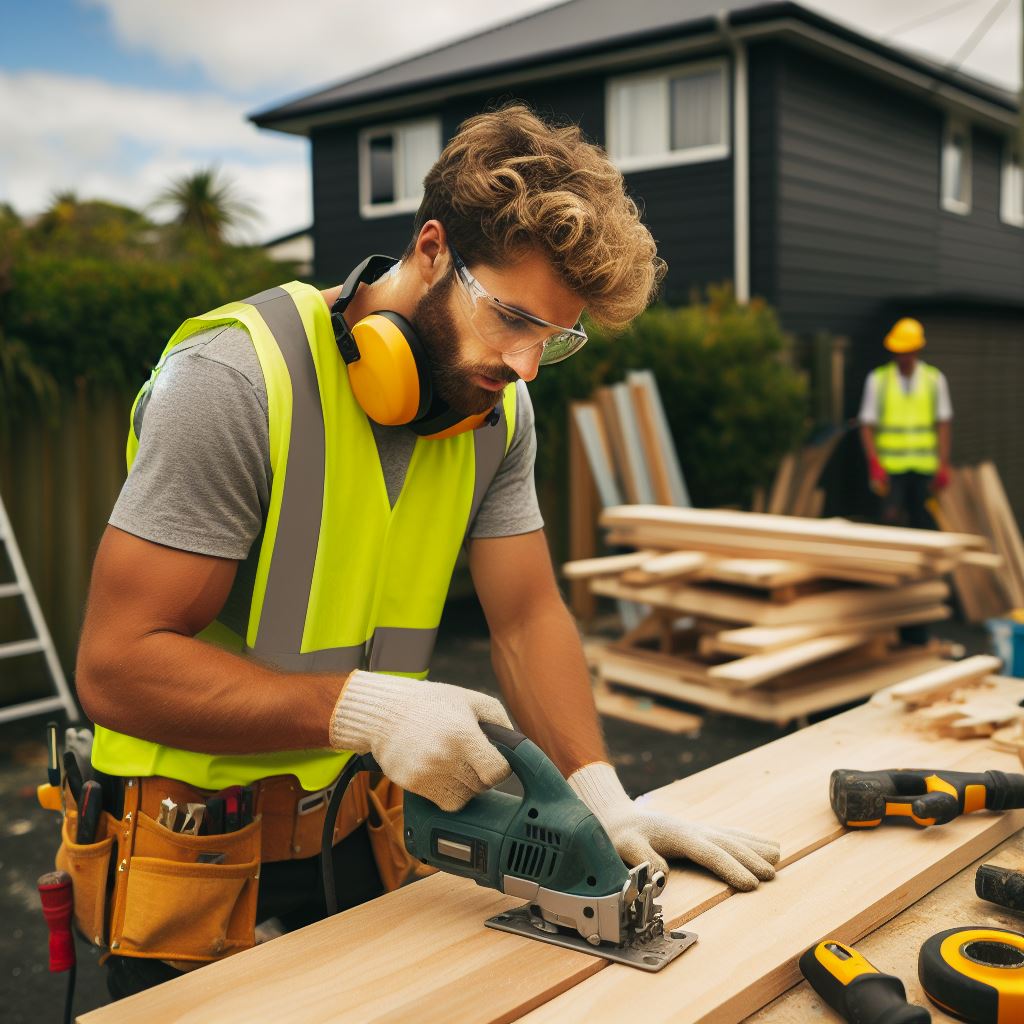Introduction
In New Zealand, knowing how to do DIY plumbing is essential for homeowners.
This blog post aims to provide NZers with important information and tips on this subject.
Importance of Knowing DIY Plumbing for NZers
Understanding DIY plumbing is crucial for NZers as it empowers them to handle minor plumbing issues without relying on professionals, saving time and money.
Brief Overview of What Will Be Covered in the Blog Post
This blog post will cover the basics of DIY plumbing, including essential tools every homeowner should have, common plumbing problems, and step-by-step guides for fixing them.
Additionally, it will discuss safety precautions, such as turning off the water supply before attempting any repairs, and when it’s best to call a professional plumber.
Furthermore, readers will learn about the importance of regular maintenance and inspections to prevent costly plumbing emergencies.
The blog post will provide useful tips for maintaining plumbing fixtures, addressing clogged drains, fixing leaky faucets, and dealing with toilet issues.
Moreover, it will advise readers on when to attempt DIY repairs and when it’s best to consult a professional, ensuring their safety and preventing further damage.
By the end of this blog post, NZers will have a solid understanding of DIY plumbing, enabling them to handle minor plumbing tasks confidently and effectively. Let’s dive into the world of DIY plumbing!
Basic Principles of DIY Plumbing
When it comes to DIY plumbing, there are a few basic principles that every New Zealander should know.
Understanding these principles can help you tackle minor plumbing issues in your home and avoid costly repairs.
Here are some fundamental principles to keep in mind
- Shut off the water supply before making any repairs or adjustments
- Always use the right tools and materials for the job.
- Follow safety precautions, such as wearing protective gear and working in well-ventilated areas.
- Understand the layout of your plumbing system and locate shut-off valves.
- Properly maintain your plumbing fixtures and pipes to prevent clogs and leaks.
Overview of Plumbing Systems in NZ Homes
Plumbing systems in New Zealand homes consist of two main components: the water supply system and the drainage system.
The water supply system brings clean water into your home, while the drainage system removes wastewater. Both systems work together to ensure a functional and hygienic plumbing system.
Understanding Water Supply and Drainage Systems
The water supply system starts at the main water source, often a municipal water supply. It then enters your home through a water meter, where you can measure your water usage.
From the water meter, the water is distributed to various fixtures in your home, such as faucets, toilets, showers, and appliances. This is accomplished through a network of pipes, valves, and fittings.
On the other hand, the drainage system is responsible for removing wastewater from your home. It begins at the fixtures and is transported to the main sewer line or septic tank.
Personalized Career Consulting
Unlock your potential with expert career advice tailored to your goals. Get personalized guidance and actionable steps toward your dream career in New Zealand.
Get StartedUnderstanding how these systems work can help you diagnose plumbing problems and make informed decisions when it comes to repairs or improvements.
Importance of Water Pressure and Its Impact on Plumbing
Water pressure plays a crucial role in the proper functioning of your plumbing system. It refers to the force that pushes water through the pipes and out of the fixtures.
Insufficient water pressure can result in weak water flow, while excessive pressure can cause damage to pipes, fixtures, and appliances. Finding the right balance is essential.
High water pressure can be controlled using a pressure-reducing valve, while low water pressure may require boosting with a water pump.
Maintaining proper water pressure can help prevent leaks, improve fixture performance, and extend the lifespan of your plumbing system.
In essence, understanding the basic principles of DIY plumbing is essential for every homeowner in New Zealand.
By familiarizing yourself with the plumbing systems in your home, you can confidently handle minor repairs and maintenance tasks.
Remember to always prioritize safety, use the right tools and materials, and consult a professional if you encounter a complex plumbing issue.
Tools Required for DIY Plumbing Projects
- Adjustable wrench
- Pipe wrench
- Hacksaw
- Plunger
- Teflon tape
- Plumber’s tape
- Plumber’s putty
- Plumbing snake
Every DIY plumber should have these essential tools in their arsenal
- An adjustable wrench is crucial for tightening and loosening various plumbing fittings.
- A pipe wrench allows for a firm grip when dealing with pipe connections.
- When it comes to cutting pipes, a hacksaw is a reliable tool to have.
- A plunger is a must-have for unclogging toilets and drains.
- Teflon tape is essential for creating leak-free connections between threaded plumbing fittings.
- Plumber’s tape, also known as thread seal tape, is used for sealing pipe threads.
- In cases where watertight seals are required, plumber’s putty comes in handy.
- A plumbing snake is useful for clearing stubborn clogs in pipes and drains.
While the above tools cover the basics, there are some optional tools that can make DIY plumbing projects easier
- A basin wrench is useful for tightening and loosening nuts in hard-to-reach areas.
- For more precise pipe cuts, a tube cutter is an excellent addition to your toolkit.
- A hand auger, also known as a drain snake, is an alternative to a plumbing snake for smaller clogs.
- A pipe bender is necessary when working with copper pipes that require bending.
- For soldering copper pipes, a propane torch and flux are indispensable.
When undertaking any DIY plumbing project, safety precautions and protective gear should be a top priority
- Always wear protective eyewear to shield your eyes from debris.
- Disposable gloves are essential to protect your hands from chemical cleaners and potential contaminants.
- When working in tight spaces or under sinks, knee pads provide comfort and protect your knees.
- It’s advised to wear a dust mask when cutting or sanding pipes to avoid inhaling harmful particles.
- For projects involving soldering, a fire extinguisher should be easily accessible.
By having the right tools and taking necessary safety precautions, DIY plumbing projects can be successfully completed
Read: Carpenter Apprenticeships in NZ Explained
Common DIY Plumbing Tasks and How to Tackle Them
When it comes to DIY plumbing, there are several common tasks that New Zealanders may encounter.
While some may seem daunting, with the right techniques and tools, many can be tackled successfully. Here are a few common DIY plumbing tasks and how you can handle them:
Fixing leaky faucets and pipes
Leaky faucets and pipes are not only annoying but can also waste water and increase your utility bills. To fix a leaky faucet, start by turning off the water supply and then disassembling the faucet.
Inspect the various components, such as the O-rings and washers, and replace any worn-out parts. Reassemble the faucet and turn on the water supply to check for leaks.
When it comes to leaky pipes, identify the source of the leak and determine the appropriate repair method.
This may involve using pipe joint compound, epoxy resin, or even replacing a section of the pipe.
Unclogging drains and toilets
Clogged drains and toilets are common plumbing issues that can be easily resolved with the right tools.
For drain clogs, start by using a plunger to create suction and dislodge any blockages.
If the clog persists, consider using a drain snake or auger to remove the obstruction.
When dealing with a clogged toilet, a plunger is often the most effective tool.
Place the plunger over the drain hole, create a seal, and pump forcefully to dislodge the clog. If necessary, use a toilet auger for more stubborn blockages.
Installing new fixtures and appliances
Installing new fixtures and appliances can be a rewarding DIY plumbing project. Before starting, make sure you have the necessary tools and materials.
Follow the manufacturer’s instructions carefully to ensure proper installation. When installing fixtures, such as faucets or showerheads, use thread seal tape to prevent leaks.
For appliances, such as dishwashers or washing machines, ensure the correct connections are made for water supply and drainage.
Test the installed fixture or appliance for any leaks or issues before completing the project.
Transform Your Career with a Professional CV and Cover Letter
Stand out to employers with an ATS-optimized resume and tailored cover letter designed to match your dream role. Let us craft your job application materials for success!
Get StartedReplacing or repairing damaged pipes
If you encounter damaged pipes, it is crucial to address the issue promptly to prevent further damage or water wastage.
Before replacing or repairing a pipe, make sure to turn off the water supply to the affected area.
Depending on the extent of the damage, you may need to cut out the damaged section and replace it with a new piece of pipe.
Alternatively, you can use pipe repair clamps or epoxy putty to temporarily fix minor leaks until a permanent solution can be implemented.
Always double-check your repair work to ensure proper sealing and functionality.
While tackling DIY plumbing tasks can be empowering, it is important to know your limitations.
If a task seems too complex or you are unsure about the required steps, it is best to consult a professional plumber.
DIY plumbing can save you money and provide a sense of accomplishment, but improper repairs can lead to costly water damage and further complications.
When in doubt, seek expert advice to ensure the job is done correctly and safely.
Read: NZ Carpentry: Skills and Tools Needed

DIY Plumbing: When to Call a Professional Plumber
In certain situations, attempting DIY plumbing may not be sufficient to resolve the issue. Below are situations that call for professional assistance:
- Leaking Pipes: If you notice a persistent leak, especially in the main water supply line, it’s time to call a professional plumber. They have the knowledge and tools to fix the problem accurately
- Low Water Pressure: If your water pressure suddenly drops, it could be a sign of a larger issue, such as a blockage in the pipes. A licensed plumber can identify and fix the underlying cause of this problem.
- Clogged Drains: Although you can handle minor drain clogs with a plunger, stubborn or recurring clogs require the expertise of a professional plumber. They have specialized equipment to clear blockages effectively.
- Sewage Backup: Dealing with sewage backups is not only unpleasant but also a health hazard. It’s crucial to contact a professional plumber immediately to prevent contamination and further damage.
- Burst Pipes: Burst pipes can cause significant damage to your property, leading to costly repairs. A licensed plumber has the skills to repair or replace the burst pipes efficiently, preventing further water damage.
Let’s discuss some warning signs that indicate potential plumbing emergencies
- Slow Draining: If your sinks, tubs, or showers are draining slower than usual, it could indicate a clog forming deeper in the plumbing system. Addressing it early can prevent a complete blockage.
- Gurgling Sounds: Strange gurgling or bubbling noises coming from your drains or toilet may signify a drain blockage. It’s better to consult a professional plumber before the situation worsens.
- Foul Odors: Persistent foul smells from your drains can indicate a sewer line issue. Ignoring this warning sign can lead to severe plumbing problems and health hazards.
- Mold Growth: Mold growth on walls, ceilings, or floors can be a result of water leaks in your plumbing system. A professional plumber can help locate and fix the source of the leak.
The benefits of hiring a licensed plumber go beyond just resolving immediate plumbing issues
- Expertise: Licensed plumbers have undergone extensive training and possess the necessary skills to handle complex plumbing problems effectively.
- Safety: Plumbing can involve handling hazardous materials and working with potentially dangerous equipment. Professional plumbers follow safety protocols to minimize risks.
- Quality Workmanship: Hiring a licensed plumber ensures that the job is done right the first time. They have the experience and knowledge to provide long-lasting solutions to your plumbing issues.
- Insurance Coverage: If any damage occurs during the plumbing repair or installation process, a licensed plumber’s insurance will cover the cost of repairs, relieving you of any financial burden.
- Code Compliance: Professional plumbers are well-versed in local building codes and regulations. They ensure that all installations and repairs meet the required standards, avoiding potential penalties.
In Short, while DIY plumbing can be effective for minor issues, certain situations call for professional help.
By recognizing warning signs and hiring a licensed plumber, you can ensure the safety and integrity of your plumbing system.
Read: Top Carpentry Courses in New Zealand
Resources and References
Websites
- www.plumbingworld.co.nz: A comprehensive website providing DIY plumbing tips and guides.
- www.mbie.govt.nz: Ministry of Business, Innovation and Employment for plumbing regulations.
- www.plumbingconnection.co.nz: Offers useful information and articles on plumbing in New Zealand.
Videos
- DIY Plumbing 101″ by DIY with Dan: A step-by-step video guide for basic plumbing repairs.
- “Mastering Plumbing Techniques” by The Handyman’s Toolbox: Provides advanced plumbing techniques and tips.
Books
- “Plumbing: A Step-by-Step Guide” by Andy Blackwell: A comprehensive book covering various plumbing projects.
- “The Complete Guide to Plumbing” by Black & Decker: A practical guide for DIY plumbing repairs and installations.
Contact Information for Local Plumbing Professionals
Auckland Plumbing Services
- Phone: 0800 200 678
- Email: info@aucklandplumbingservices.co.nz
- Website: www.aucklandplumbingservices.co.nz
Wellington Plumbing Experts
- Phone: 0800 100 200
- Email: info@wellingtonplumbingexperts.co.nz
- Website: www.wellingtonplumbingexperts.co.nz
Christchurch Plumbing Solutions
- Phone: 0800 500 400
- Email: info@christchurchplumbingsolutions.co.nz
- Website: www.christchurchplumbingsolutions.co.nz
Safety Guidelines and Plumbing Regulations in NZ
- Always turn off the water supply before starting any DIY plumbing tasks to avoid flooding.
- Use appropriate safety gear such as gloves and goggles to protect yourself from potential hazards.
- Follow the plumbing regulations set by the New Zealand Building Code for safe and compliant installations.
- Ensure proper ventilation when working with plumbing fixtures or chemicals to prevent inhalation of harmful fumes.
- When in doubt or facing complex plumbing issues, consult a licensed plumber to avoid further damage or risks.
Remember, while DIY plumbing can save you money, it’s essential to prioritize safety and follow regulations to prevent accidents or damage.
Always hire a professional if you’re uncertain about handling a specific plumbing task.
By utilizing the recommended resources, contacting local plumbing professionals, and following safety guidelines, you can approach DIY plumbing in New Zealand with confidence and success.
Read: Carpentry 101: A Guide for Kiwi Beginners
Conclusion
In this blog post, we discussed the key points that every DIY plumber in New Zealand should know.
We emphasized the importance of understanding the plumbing system in your home and the basic tools you need to have.
We also highlighted the common plumbing issues that can be easily fixed by homeowners, such as unclogging drains or replacing faucets.
By tackling these tasks yourself, you can save money and gain valuable skills.
However, it’s crucial to know your limits and when to call a professional plumber.
Some plumbing problems require specialized knowledge and equipment, which is why it’s essential to evaluate the complexity of the task before starting.
Lastly, DIY plumbing can be a rewarding and cost-effective endeavor for New Zealanders.
By following the tips and guidelines provided in this blog post, you can successfully handle basic plumbing tasks in your home.
Remember to always prioritize safety, read instructions carefully, and have the necessary tools and materials.
If you’re unsure about any plumbing task, it’s better to seek professional help rather than risking further damage.
Boost Your Career with a Standout LinkedIn Profile
Attract recruiters and expand your network with a fully optimized LinkedIn profile tailored to highlight your strengths and professional goals. Let your profile open doors to new opportunities!
Get OptimizedWith the right knowledge and cautious approach, you can become a confident DIY plumber and resolve common plumbing issues in your home with ease.




